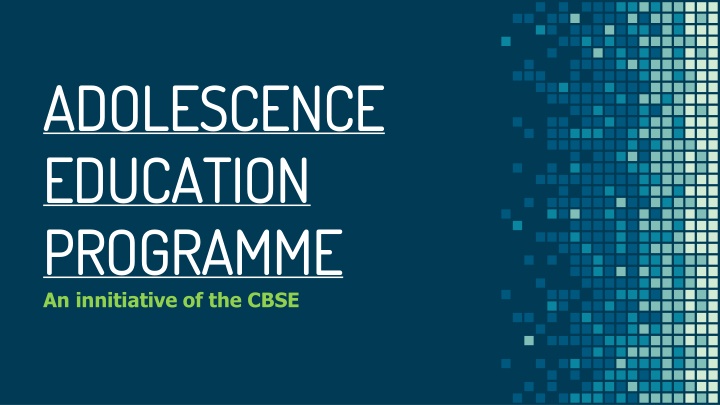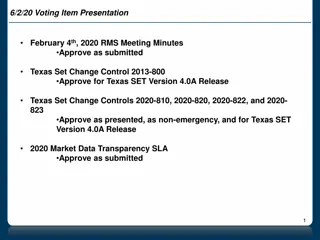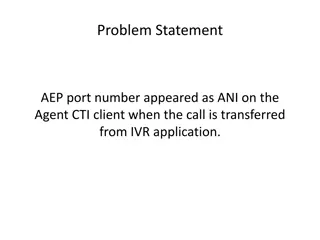
Adolescence: A Comprehensive Educational Initiative by CBSE
Explore the stages of adolescence, its physical and psychological aspects, societal challenges, and the importance of education through the CBSE programme. Learn about growth, hormonal changes, brain development, stereotypes, mental processes, and more for a holistic understanding of the adolescent journey.
Download Presentation

Please find below an Image/Link to download the presentation.
The content on the website is provided AS IS for your information and personal use only. It may not be sold, licensed, or shared on other websites without obtaining consent from the author. If you encounter any issues during the download, it is possible that the publisher has removed the file from their server.
You are allowed to download the files provided on this website for personal or commercial use, subject to the condition that they are used lawfully. All files are the property of their respective owners.
The content on the website is provided AS IS for your information and personal use only. It may not be sold, licensed, or shared on other websites without obtaining consent from the author.
E N D
Presentation Transcript
ADOLESCENCE ADOLESCENCE EDUCATION EDUCATION PROGRAMME PROGRAMME An innitiative of the CBSE
AGENDA AGENDA The process of Growing Up The process of Growing Up Understanding and Challenging Stereotypes and Discrimination Understanding and Challenging Stereotypes and Discrimination Prevention of Substance/Drug Misuse Prevention of Substance/Drug Misuse Prevention of HIV and AIDS Prevention of HIV and AIDS 2
SECTION 1 THE PROCESS OF GROWING UP THE PROCESS OF GROWING UP 3
ADOLESCENCE ADOLESCENCE Stage of development which precedes adulthood Spanning the ages between 10 and 19 years Time of great physical change in young people Characterized by rapid growth, hormonal change, changes in bodily appearance, changes in brain structure 4
Special attributes that mark adolescence: Special attributes that mark adolescence: Rapid physical growth and development Physical, social and psychological maturity, not necessarily at the same time Sexual maturity and onset of sexual activity Experimentation Development of adult mental processes and adult identity Transition from total socio-economic dependence to relative independence 5
Brain vs. Hormones Brain vs. Hormones Two main elements that affect maturity of both body and emotions Hormonal changes lead to and guide the body through puberty, resulting in sexual maturity The brain develops and changes throughout childhood and adolescence 6
Adolescence and Sleep Adolescence and Sleep Physiological need for more sleep, probably because they are growing rapidly Change to the secretion of the hormone melatonin, which controls sleep 7
Physical changes during Adolescence 8
PHYSICAL CHANGES GIRL BOY Starts at about 10 years of age and peaks at 12, weight gain, broadening of the hips Increased production of androgen hormones in both sexes leads to increase in skin thickness and stimulates the growth of sebaceous glands Starts at about 12 years of age, weight gain, Growth of arms, legs and penis Growth Spurt Activation of Oil and Sweat Glands No significant change Enlargement of the larynx, deepening of the voice Appearance of pubic hair, hair growth on the chest, the armpits and on the face Sometimes the breast can become prominent Voice Growth of pubic hair, body hair become coarser and there is growth of hair in the armpits Starts between 8 and 13 years and is completed between 13 and 18 yrs Reproductive and sexual organs attain maturity during adolescence Growth of Hair Breasts Reproductive & Sexual Organs 9
Emotional Changes Emotional Changes Strong feelings and intense emotions at different times. Moods might seem unpredictable. More self-conscious, especially about physical appearance and changes Invincible stage of thinking and acting as if nothing bad could happen to him 10
Social Changes Social Changes Searching for identity Seeking more independence Seeking more responsibility, both at home and at school Looking for new experiences Thinking more about right and wrong 11
Anger Reducing Techniques : to get rid of anger Anger Reducing Techniques : to get rid of anger R = Recognize your anger signals and accept that you are angry I = Identify a positive way to analyze the situation D = Do something constructive to calm down 12
Stress Coping Activities Stress Coping Activities Laugh hard Breathe deeply Listen to your favourite music Feel the morning sunshine Practice shrugging Yoga 13
Nutritional Needs of Adolescents Nutritional Needs of Adolescents 14
Body Mass Index (BMI) Body Mass Index (BMI) BMI CATEGORY Measure of body weight to height <18.5 Under Weight Known as Quetelet s Index 18.5 24.9 Normal Weight Use to determine if a person is underweight, optimum weight, or 25 29.9 Over Weight over weight >30.0 Obese BMI= Weight in kilograms/ height in meters 15
Some Common Nutritional Disorders Some Common Nutritional Disorders Nutritional Anaemia Bulimia Nervosa Anorexia Nervosa 16
Early Marriage Early Marriage Legal age at marriage 18 years for girls and 21 years for boys National Family Health Survey(2005-06) show that Legal age at marriage 27% young women and 3% young men in the age group 15-19 were married at the time of the survey 30% women in the age group 15-19 had a live birth by the age of 19 years 17
Adolescent Pregnancy Adolescent Pregnancy Leads to great health risks to the teenage mother and her child Mother is more likely to suffer from anemia Chances of prolonged labour that can result in severe damage to the reproductive tract Low birth-weight babies Increases the risks of maternal and child morbidity and mortality 18
SECTION 2 UNDERSTANDING AND UNDERSTANDING AND CHALLENGING STEREOTYPES CHALLENGING STEREOTYPES AND DISCRIMINATION AND DISCRIMINATION 19
Sex vs. Gender Sex vs. Gender Sex Biologically determined Sex Gender Gender Influenced by the interaction of biological, psychological, social, cultural and historical factors A concept made by society, teaching us how men and women should behave and how they are expected to act Roles and qualities vary from society to society 20
Changing Gender Roles Changing Gender Roles Most are aware that gender roles cannot remain fixed and they are eager to be part of the change Most school-going adolescents feel positive about girls studying and entering various careers Girls and boys both want a partner who will understand 21
Burden of Work on Women Burden of Work on Women The data below from a special study done by the Central Statistical Organization of India (1998-1999) State Wom en paid (work hours per week) Women unpaid (housewo rk hours per week) Wome n (total) Men paid (work hours per week) Men Unpaid (housewo rk hours per week) Men (total) Haryana 23 30 53 38 2 40 Tamil Nadu 19 35 54 40 4 44 22
Sex Selection Sex Selection Use of ultrasound technology has become the most common mode of sex determination Child Sex Ratio is calculated as the number of girls per 1000 boys in the 0-6 years age group In India, the ratio has shown a sharp decline from 976 girls to 1000 boys in 1961 to 914 as per the 2011 census The practice of dowry and the tag of paraya dhan further translate into daughters being seen as liabilities 23
Domestic Violence Act, 2005 Domestic Violence Act, 2005 Domestic violence - physical abuse, sexual abuse, verbal and emotional abuse as well as economic abuse Ensures a woman s right to reside in shared household Ensures that a court may pass a protection order Provides for the women s right to her stridhan or any other property 24
Seeks the appointment of Protection Officers and service providers by the State Section 498 A provides for a criminal complaint in case of domestic violence Ensures that police arrest the perpetrators after preliminary enquiries Seeks to ensure a victim s access to necessary services including health services 25
Sexual Abuse Sexual Abuse Sexual harassment is illegal and reportable under the legal provisions in India There is also a law dealing specifically with `sexual harassment in the workplace Due to the stigma attached to rape, most rape victims do not report the cases Schools have a very important role in preventing sexual harassment and abuse 26
Parent and teacher bodies like the Parent Teacher Associations may be able to establish mechanisms to facilitate reporting of sexual harassment and to support those who complain Most importantly, schools can build an attitude in children that has a zero-tolerance towards any form of abuse or harassment This is possible only in an atmosphere of genuine learning and good motivation 27
SECTION 3 PREVENTION OF PREVENTION OF SUBSTANCE/DRUG MISUSE SUBSTANCE/DRUG MISUSE 28
Types and effects of substance use Types and effects of substance use Group Drugs Effect the user feels Benzedrine Dexedrine and Methedrine, Cocaine, Nicotine,Tobacco, Caffeine, Gutka, Pan masala Accelerate the brain. Long term use may result in cancer of the lungs, mouth, larynx, oesophagus, bladder, kidney or pancreas Stimulants Alcohol, Barbiturates Tranquilizers, inhalants Slow down activity of the brain. Inflamed stomach and pancreas Depressants Hypnotic like Mandrax, Doriden Deep sleep, loss of consciousness and even death Sedatives Opium, Morphine, Codeine, Heroin, Brown Sugar, Methadone Reduces pain and anxiety. Higher doses lead to sedation, nausea and unconsciousness Narcotic/ Analgesics Bhang (Marijuana), Ganja, Charas Leads to relaxation, drowsiness, talkativeness and unconsciousness Cannabis LSD, Mescaline, Psilocybin, Cannabis Distort the way in which individuals see, hear and feel, strong negative effects and psychiatric complications Hallucinogens Glue, gassing, sniffing, chemo. feelings of euphoria that are characterized by lightheadedness, exhilaration and vivid fantasies, slows down body Functions Inhalants 29
Consequences of Substance Misuse Consequences of Substance Misuse Short Short- -term Effects: term Effects: Long- -term Effects: Long term Effects: False sense of well-being and Progressive damage to different a pleasant drowsiness. Some body organs of the impairs both physical and Distorted vision, hearing and mental functioning leading to coordination, impaired compromised quality of life judgment, bad breath and include irregular eating habits, hangovers poor hygiene resulting in poor health and low immunity 30
Prevention of substance misuse: Prevention of substance misuse: Developing skills to manage peer pressure Different ways of dealing with negative peer pressure are saying No assertively Empowered with adequate information and skills Encourage the adolescents to get engaged in socially productive activities 31
Substance Misuse and the Law: Substance Misuse and the Law: Prohibition of smoking in public places Prohibition of advertisement of cigarette or other tobacco products Sale of cigarettes and other tobacco products to a person below the age of 18 years is not Allowed sale of cigarettes within 100 meters of a school is also banned 32
Laws pertaining to Alcohol include Laws pertaining to Alcohol include Licensing Laws regulate retail supply Legislation on drunkenness, defining intoxication as an offence under certain circumstances Road traffic legislation makes driving while under the influence of alcohol an offence when blood alcohol level exceeds a certain value (30 mg/100 ml of blood) detected by breath analyzer Minimum age of drinking varies in different states 33
Treatment for Substance Misuse Treatment for Substance Misuse Adopting a combination of approaches, including medication, behavioral changes and health care for physical and psychological symptoms Professional counseling or Drug De-addiction interventions for prevention must begin early Teachers should try to share the problems, academic and personal of the learners and guide them 34
SECTION 4 PREVENTION OF HIV AND AIDS PREVENTION OF HIV AND AIDS 35
What is HIV? What is HIV? HIV stands for: o H : Human (This virus survives only in human body) o I : Immunodeficiency (Virus produces weakness or inadequacy of the body s main defense mechanism, the immune system) o V : Virus 36
Human Immunodeficiency Virus (HIV) Human Immunodeficiency Virus (HIV) Belongs to a family of viruses called retroviruses. Tiny, a thousand times smaller than the thickness of a hair Attaches itself to the genetic material of the human cells it has infected Hard for either the body or drugs to deal with it, without destroying the cell itself 37
What is AIDS? What is AIDS? o Acquired : Not genetically inherited but one gets it from an infected person o Immune Deficiency : Weakness or inadequacy of the body's main defense mechanism, the immune system. o Syndrome : Not just one disease or symptom but being present in the body as a group of diseases or symptoms Diagnosed by blood test at an authorized laboratory 38
How is HIV transmitted? How is HIV transmitted? How is HIV not transmitted? How is HIV not transmitted? Unprotected Sex (most Shaking hands, kissing & common) hugging Infected mother to new-born Sharing cups, plates and other child eating utensils Blood Sharing toilet and bathroom Through coughing or sneezing Donating blood to the Blood Bank Bites by insects 39
HIV Prevention HIV Prevention Responsible Sexual Behaviour Use of Safe Blood and Instruments In case of Mother-to-Child Transmission (MTCT), Termination of pregnancy used to be the only solution to prevent vertical transmission 40
HIV and AIDS Prevalence in India HIV and AIDS Prevalence in India Third largest number of people living with HIV/AIDS Estimated 24 lakh people living with HIV/AIDS with an adult prevalence of 0.31 percent in 2009 One in every 1000 young people in the age group 15-24 is HIV positive 41
Vulnerability of Adolescents Vulnerability of Adolescents Adolescents are more vulnerable to HIV infection because of the following reasons: Lack of correct knowledge about transmission of HIV Less likely to recognize potentially risky situations Negative peer pressure Lack of access to youth friendly services Lack of life skills needed to make informed and responsible decisions 42
What can be done: What can be done: Providing the youth with correct information on possible ways in which they can get infected with HIV Establishing a positive and sharing relationship with their parents Supportive environment in school and peers who do not engage in risky behaviors or misguide others 43
Diagnosing HIV Infection Diagnosing HIV Infection Most people with HIV show no symptoms of disease Asymptomatic HIV infection is a phase of HIV/AIDS during which there are no symptoms of HIV infection The window period represents the period of time between initial infection with HIV and the time when HIV antibodies can be detected (6 12 weeks) HIV Testing : ELISA, WESTERN BLOT, RAPID TEST 44
Integrated Counselling and Testing Integrated Counselling and Testing Centre, ICTC Centre, ICTC An Integrated Counselling and Testing Centre (ICTC), is a place where a person is tested for HIV and counselled Confidential testing and counseling for HIV Linking individuals with other HIV prevention, care and treatment services Provision of basic information on modes of transmission and prevention of HIV/AIDS On detection of sero-negative case, identifying risk behaviors and providing counseling to help them stay negative 45
Reproductive Tract Infections Reproductive Tract Infections - -RTIs RTIs Occur in the reproductive tract of both men and women Caused by bacteria, viruses or protozoa RTIs include all infections of the reproductive tract whether transmitted sexually or not Practice of proper genital hygiene can prevent RTIs For cure of RTIs, patient should seek advice and treatment of qualified doctors 46
Sexually Transmitted Infections Sexually Transmitted Infections - -STIs STIs Transmitted from one partner to another during unprotected sexual activity Common STIs are Gonorrhoea, Chlamydia, Syphilis and HIV etc STIs put a person at a greater risk of getting and transmitting HIV Most STIs are easy to treat, if they are detected and treated early 47
Symptoms of some prevalent STIs Symptoms of some prevalent STIs STIs Gonorrhea Symptoms vaginal discharge, burning or painful urination, pus- like discharge from the penis (in boys) similar to those of gonorrhea Chlamydia Syphilis appearance of a chancre (painless ulcer) at the site of initial exposure burning and itching of the genital area, blisters or sores on the genitals, discharge from the vagina or penis Herpes Simplex Virus warty growths of HPV can appear on the external or internal reproductive organs Human Papilloma Virus (HPV) Human Immunodeficiency Virus (HIV) rash, fever, enlarged lymph nodes, and a flu-like illness, weight loss, chronic cough, fever, fatigue, chronic diarrhea 48
THANKS! Any questions? Anahita Singh anahita@udayapulicschool.edu.in 49









